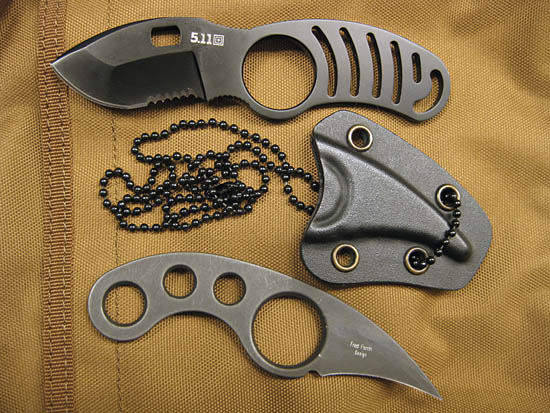[Ed. note – This is part three in a four part police training series on duty knives. Make sure you read Randall’s other articles in the series on his general thoughts about police knives, the KA-BAR TDI and folding knives.]
In Police Knives (part I), I discussed some “old school” patrol knife carry methods. For Part II, I’d like to talk about some fixed blade knives. Some of the officers I know carry small neck knives attached to various places on their persons.
Neck knives are generally small, slim blades with a low profile that can be mounted in a variety of ways. They are named after the carry method of wearing the knife around the neck in a small sheath, either hung there with 550 paracord or a break-away neck chain (or ball chain).

I do not recommend paracord for a neck knife for the same reasons cops don’t wear regular neckties. Paracord makes a handy ligature or garrote with which to strangle its wearer. For safety, a break-away chain will part after only a few pounds of pressure.
If a neck knife is worn suspended from a chain inside the uniform shirt, it may shift during physical movement and render itself unreachable. This is fine for civilian carry under a shirt (observing the local laws) or LEO off-duty wear, but is not functional for a patrol officer or deputy.
Neck knives can be carried in a front or rear pocket with the lanyard or cord attached to the belt. When drawing the knife in this fashion, you pull the knife out of the sheath with one hand as the lanyard becomes taut. The knife and sheath part company with the force of the draw.
Today’s neck knife sheaths regularly come made from Kydex, Zytel, Concealex, or some other molded-plastic derivative. This makes the sheaths impervious to weather. It also gives them a variety of mounting options. One of these is strapping, zip-tying, or M.O.L.L.E. attaching them to concealed body armor. One of my friends has his small knife sheath secured to a ballistic vest strap so he can access the knife by reaching just inside his uniform shirt at the collar.
Though we talked about boot knives in Part I, 5.ll has a nifty pocket sewn into the upper portion of their boots. This pocket accepts either 5.11’s Side Kick sheath, or one that shares similar dimensions. I found that my Emerson La Griffe neck sheath is extremely snug in this pocket. I actually had trouble removing the sheath with the boot off of my foot.
I have been experimenting with this exception to my no-boot-knives rule, as the 5.11 boot/sheath set up is very secure. Additionally, the handles of both knives are diminutive, making them tough for an adversary to notice (or grab). Both traits are a departure from older, more cumbersome, boot knives.
The 5.11 Side Kick boot knife, Fred Perrin-designed La Griffe, and Columbia River Knife and Tool Bear Claw all share a 1” hole at the forward part of the handle to accept your index finger. These knives are difficult to disarm because of their integrated grip in the hand and their short (1.75” to 2.375”) blades. They are potent back-up weapons in skilled hands.
In the third part of this series, I’ll discuss my take on the KA-BAR TDI.